
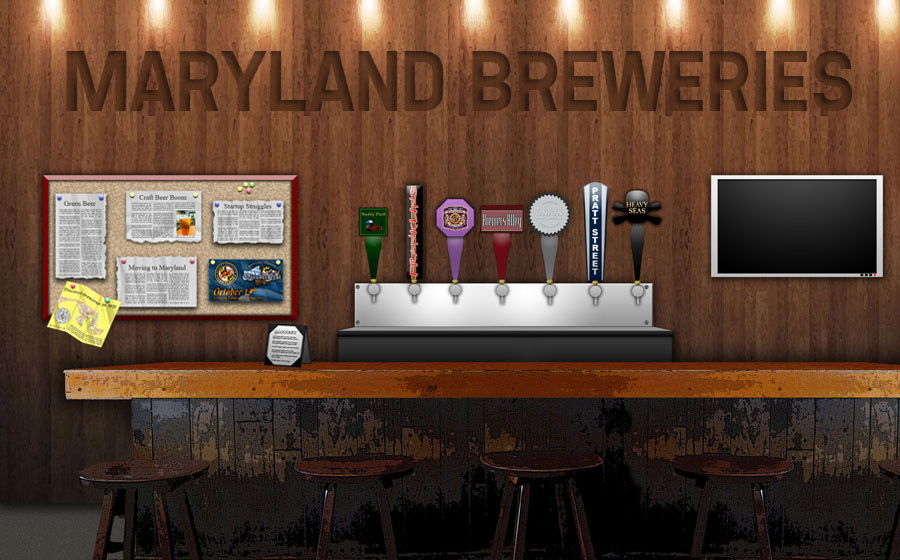
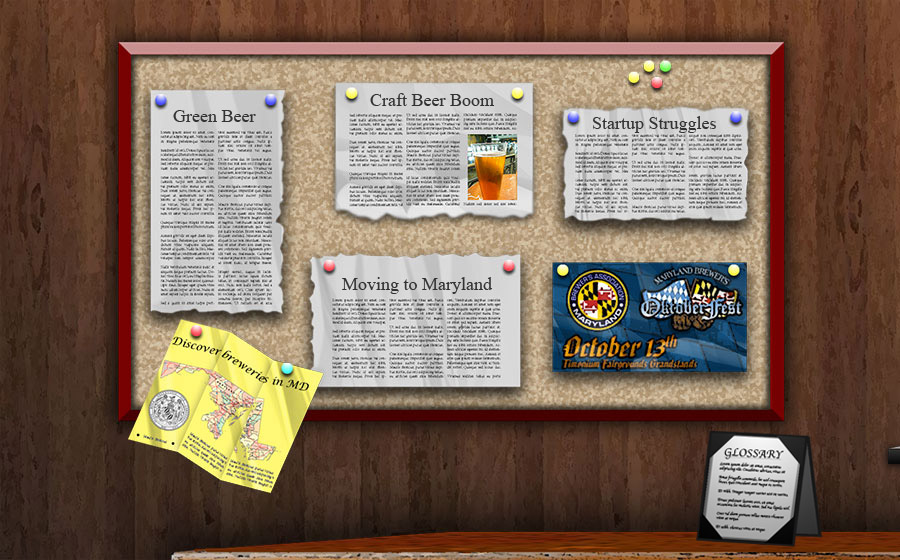








HAMPSTEAD - In this tranquil town near the Pennsylvania border, there is a farm, like its neighbors, that has a rolling field and bright red barn. But the field has no corn or livestock. Instead, it is freshly harvested and waiting for new hop vines to grow. This is Creeping Creek Farm, the site of Ruhlman Brewing Company.
Incorporating fresh from the farm ingredients in brewing is good for the environment, great for beer flavor and excellent for alleviating expenses. Maryland brewers are catching on to the benefits of sustainable brewing and even branching out beyond the farm to try other sustainable practices. But it's not always easy.
For starters, maintaining a sustainable brewery is not a solo endeavor. Local communities frequently collaborate with breweries. Burley Oak Brewing Company in Berlin, near Ocean City, recently began a hop-sharing program. Local residents received hop rhizomes (a clipping of the hop flower used in brewing) and grew them over the summer. This fall, the community will harvest the hops and deliver them to Burley Oak for the brewing of a community hop beer.

"Our specific location in the state of Maryland is very beneficial to us because we're surrounded by agriculture and brewing is a very agricultural industry," said Bryan Brushmiller, Burley Oak Brewing Company owner and brewer.
It's not all about the environment though. For Burley Oak, the local community is a major motivator for implementing sustainable brewing practices.
"The people who really support us, who sustain our business, are local people," Burley Oak head brewer Sean Saffcaf said. "So we want to make sure we do as much with them as possible."
Ruhlman Brewing craves community interaction. The farm brewery encourages visitors with tastings on the weekend and its challenging disc golf course.
"I have one man who brings his son," Ruhlman said. "He's been out here four times, every weekend since he found the place. He loves it. He comes out and every time he comes he brings another one of his son's friends with them, and then they bring their fathers. So he's actually growing this. The community really is behind me."
Additionally, sustainable brewing can benefit the business. Brushmiller describes it as basic economics: when local farmers and vendors sell to the brewery their profits increase, which puts more money in their pocket to purchase more beer.
It all starts on the farm. Hops, an essential ingredient in the brewing process, thrive in the soil and climate of Maryland and help local farmers diversify their crops.
For Adam Frey, a farmer from northern Mt. Airy, hops were the perfect addition to his farm. "We decided to start growing hops because right now hops are kind of hot, but at the same time the entire intention was to open a farm brewery," said Frey, who is in the process of acquiring a Class 8 Farm Brewing License.
Maryland Gov. Martin O'Malley signed Senate Bill 579 in May to establish the Class 8 license. It requires the use of Maryland-grown ingredients, either hops, grain, fruit or a combination of the three. No minimum percentage of local ingredients is specified and the brewery does not have to be on an actual farm. Production is limited to 15,000 barrels per year. Growlers, cases and kegs can be sold to carry away, and up-to six ounces of beer per brand can be sold for on-site imbibing.
Growing or sourcing local hops is a smart choice, but not the only one. Additional ingredients can come directly from Maryland farms. Ruhlman plans to make a pumpkin beer for fall with the pumpkins from his little patch. Ruhlman also has a persimmon tree nestled in the heart of his property that might be used to brew a persimmon beer in the future.
Barley, another agricultural product vital to the brewing process, can be grown in Maryland. Using home grown or locally sourced ingredients eliminates transportation costs.
"We're not paying shipping costs to ship grain from the Midwest," said Brushmiller, who sources hops and grains from local farmers in Berlin. "We have to think -- to have sustainable practices and be responsible -- about the fact that it always burns a lot of oil to move large amounts across the country."
After the brewing process, the grains become spent. "Most of all, what breweries do, is find a source for their waste: specifically, the thousands of pounds of spent grain used in the brewing process," Brushmiller said. "We, like every other brewery, can give to local farmers to feed their cattle." Heavy Seas, a local Maryland beer company, also donates their spent grain to local farmers.
Sustainable brewing does not stop with agricultural products. Water, a critical element in the brewing process, can be reclaimed and reused. Water reclamation is incredibly important, according to Saffcaf.
"What we do is we reclaim the water we use to an extent. We reclaim anything that's not used for cleaning purposes, so nothing that's picking up any chemicals," Saffcaf said. "All of the water that we use can be heated, boiled and then used back in the brewing process again."
Even the mechanics of brewing can be tweaked to help the environment. There are advanced modern technologies to transform the naturally wasteful brewing process into something sustainable.
But Ruhlman said these technologies are often unaffordable for small brewers.
A heat recovery system is expensive, but it saves energy. These systems, when added to standard brewing equipment, capture the heat that is used and return it to the process.
"Maryland is an up-and-coming scene in brewing. I know there are some of the larger brewers that are using sustainable practices, like the Flying Dogs and the Heavy Seas and what not," said Safcaff. "I'm sure they're pushing for the types of sustainable brewing practices and things that will be helpful to the brewing climate in Maryland."
COLLEGE PARK - Despite being traditionally dominated by states like Colorado and California, craft brewing has become an increasingly important industry for Maryland.
With 31 microbreweries and brewpubs currently recognized by the Brewers Association and another 15 in the planning stages, Maryland is beginning to gain national recognition as a new hotspot of beer.
"I think you can easily and fairly make the argument that Maryland is a microcosm of what's happening across the nation," said J.T Smith, executive director of the Brewer's Association of Maryland (BAM). "There's certainly a renaissance of interest in artisanal and craft brewing. There's explosive growth across the nation that's mirrored right here in the state of Maryland."
BAM began the year with 12 members. Smith projects that number will have more than doubled to "25 or 26" by the end of 2012.
"It has been a steady, consistent growth in the craft beer industry as well as here in the state of Maryland in the past twenty years," Smith said. "Over the past two to three years in particular, I would certainly call it explosive growth."
One explanation for this explosion, as offered by Smith, could be the state's fortunate demographics. Maryland boasts an exceptionally high population density and the highest median household income in the nation. Additionally, Maryland is located relatively close to several other large markets, such as New York City, Philadelphia and Washington, D.C.
"I think all of those things are going to line up with your stereotypical craft beer drinker," Smith said.
Just because the quantity of Maryland beer has increased, that does not mean that the quality has suffered. At this year's Great American Beer Festival in Denver, Maryland brewing companies took home a couple of medals, including a gold and a silver.
"Maryland beer is available around the world and is continually sought after by people coming to Maryland to visit," Smith said. "People of Europe are continually requesting and seeking Maryland beer in their home markets."
Flying Dog Brewery moved from Colorado to Frederick in 1994 and has become the flagship brewery of Maryland craft beer. With about 80,000 barrels of beer produced annually, Flying Dog ranked No. 28 on the Brewers Association's Top 50 Craft Brewing Companies based on 2010 beer sales.
"I think that all of the members [of the Brewer's Association of Maryland] are incredibly important on different levels," Smith said. "However, the larger brewers are important because they have more money to spend, more staffing with marketing plans and have a larger distribution footprint so they can get the idea as well as the fluid of Maryland beer out to a larger population. They tell our story on a larger scale."
Maryland's brewing expansion mirrors the upward trend seen nationally. According to the Brewer Association, there were 2,075 craft breweries in the U.S. on July 1, 2012, the largest amount since the end of prohibition in 1933.
It seems that every state is jumping on the craft beer bandwagon. According to the Brewer Association's database, there are currently a total of 1,290 breweries in planning stages across the country.
This growth comes in spite of yet another year of decline in overall American beer consumption, a trend that started with the recession in 2008.
"Beer is not recession proof. And the recession did impact craft breweries, but not as much as the larger brewers," said Paul Gatza, director of the Brewers Association.
In an economy that has struggled since 2008, the craft beer market has seen exponential growth over the past four years. Craft brewed beer made over $8.7 billion in revenue in 2011, up over $2.4 billion from 2008.
"Even though things were tight...buying a beer you really wanted to drink seemed like an affordable luxury," Gatza said.
Seeing the writing on the wall, large breweries have begun producing craft-like beer to appeal to this growing market. Anheuser-Busch introduced Shock Top, a Belgian-style wheat ale, in 2006 to directly compete with Molson Coors Brewing Company's Blue Moon.
Maryland has long had a strong craft brewing tradition dating back to the early 18th century.
In 1703, Benjamin Fordham opened the Fordham Brewing Co., Maryland's first commercial brewery, in Annapolis. Forty-five years later, Baltimore's first brewery opened its doors. Breweries in towns such as Frederick and Cumberland began sprouting up around the same time.
As Maryland's German immigrant population grew, so did its beer culture.
"Baltimore always was drinking a lager/pilsner kind of beer, historically, because there were so many German breweries in Baltimore," said Stephen Demczuk, president of Baltimore Washington Beer Works. "You look at Bauernschmidt and people like that, they ruled the Baltimore brewing industry, so we always were drinking German-style beers."
Maryland brewing took a hit in the early 20th century, however, as less than half of the state's breweries reopened after the 13 years of prohibition, according to a 2005 history written by Demczuk.
The 1960s saw the rise of the National Brewing Company, which produced Baltimore favorites National Bohemian Beer and National Premium. During the late 1980s and early 1990s, brewpubs and microbreweries began opening across the state.
More recently, Maryland politicians have been working to make the state's laws more brewer-friendly. In May, Gov. Martin O'Malley signed Senate Bill 579, which established the Class 8 Farm Brewing license.
Under the new legislation, farmhouse breweries are limited to producing 15,000 barrels a year. The breweries do not have to be located on a farm, but they are required to use Maryland-grown ingredients in their beers.
In return, these breweries will be allowed to both sell their beer and serve up to six ounces of each beer style on site. In other words, farm brewers are afforded the same privileges as Maryland wineries, with the exception of self-distribution.
"One of the drawbacks to what was Maryland's existing language was that you had to be tied in with a restaurant under that use," said state Sen. Barry Glassman (R-Harford County), sponsor of Senate Bill 579. "So there was a lot of investment that had to be done to produce a restaurant and a brewery under the one umbrella."
Now that farmers looking to use their crops to brew beer are able to do so without the hassle of opening a restaurant, the door is open for the Maryland craft brewing industry to expand even further.
According to Smith, who called the passage of Senate Bill 579 "an excellent victory for Maryland craft beer in 2012," other states have expressed interest in farm brewing.
As of now, the future of craft brewing in Maryland remains bright. But Smith said the state cannot support this kind of growth forever.
"I think that there will have to be a slowdown of growth at some point, it's only natural," Smith said. "What that level is, we're not quite sure. It's certainly something that we're staying educated about and keeping an eye on."
SALISBURY - When a craft brewery with an outlaw attitude and punchy beers and an Eastern Shore brewery with a focus on well-balanced brews moved to Maryland, their relocations added luster to the growing microbrew scene in the state.
Flying Dog Brewery moved from Denver to Frederick in 2006. Evolution Brewing Company moved from Delmar, Del., to Salisbury last year.
Both were attracted by Maryland's fermenting beer culture and the chance to operate in a strategic spot to corner the Mid-Atlantic craft beer market.
Evolution
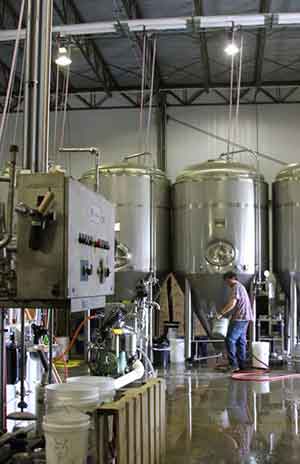
Evolution Craft Brewing Company, nicknamed Evo, decided to make the 10-mile move from Delmar to Salisbury in part because of a state sponsored loan through the Maryland Dept. of Business and Economic Development. But beyond that, Evo's restaurateur owners, Tom and John Knorr, have Maryland connections.
John lives in Baltimore and Tom on the Eastern Shore. Together, they started several seafood restaurants in the state. In 2009, the brothers launched Evo with the goal of creating beer to complement quintessential Maryland food like Old Bay-encrusted seafood.
"For us as a company, we miss being in Delmar a little bit too because it had a small town feel...a family type atmosphere," said Denny Mogan, Evo's general manager.
But he said that Evo had outgrown its Delmar site. "The problem in Delmar was always our ability to keep up with demand," he said. Evo is distributed across Maryland, Delaware, Virginia, Washington, D.C., and recently expanded into Pennsylvania.
The new Salisbury facility in a former ice factory allowed Evo to expand its capacity to 7,500 barrels with room to grow to 10,000. On a recent fall day, the brewery was bustling, with a sweetly pungent scent in the air and puddles of water on the floor.
Brewer Kerry Williams manned the fermentation tanks and brewmaster Geoff DeBisschop hustled from one area to another overseeing operations. Piling up in a large plastic bin was used malt that would later go to a local farmer who uses it as cattle feed.
The new Evo site also has a brewpub restaurant with a menu designed to complement Evo's beer.
"[John and Tom] are restaurateurs first so the restaurant was always a huge goal for them," Mogan said. "It's a showpiece for the brand."
But unlike at the Knorr's other Southern Boys Concepts restaurants, there are no Maryland blue crabs on the Evo brewpub menu. Instead, it's all about seasonal dishes incorporating local ingredients, in line with the popularity of the current farm-to-table movement.
DeBisschop likes Evo's beer to meet drinker's expectations. You'd have no trouble identifying the hoppiness in Evo's Lot No 3 IPA and the bright acidity of its Primal Pale Ale. But Mogan adds that DeBisschop also "isn't handcuffed" by style guidelines.
And Evo has plans to keep growing. "We're still in a state of constant evolution," Mogan said, no pun intended. With added equipment, the Salisbury facility will be able to keep increasing production.
"We want to be a great mid-Atlantic brewery," Mogan said. "We're not trying to bite off more than we can chew, we're just trying to do well in our niche and bring great beer to the mid-Atlantic."
Flying Dog
Over on the western side of the state, Flying Dog Brewery, the state's largest beer producer, already has a firm grip on the Eastern seaboard market and beyond.
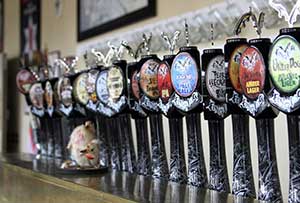
Eccentric Champion spark plug heir George Stranahan started the Flying Dog Brewpub in Aspen in 1990. Four years later it expanded to a brewery in Denver.
"In Colorado, which is kind of where the American craft beer scene started, we were a very small fish in a very large pond," said Erin Biles, Flying Dog's public relations manager.
Since Flying Dog had already had a lot of success on the East Coast, it made sense to look for facilities in the region to make distribution more cost effective.
The company settled on the former Frederick Brewing Company facilities because they were double the size of Flying Dog's Denver site and also had more modern brewery equipment. It started transitioning to Maryland in 2006 and by 2008 was brewing all its beer in Frederick.
"Knowing the beers from Colorado to here, they were just as good here as there and I think better," said Flying Dog brewer Keith Kohr. "I think we're really well suited here. We have our feet really dug in."
The brewery has been inspired by its new home state. Kohr created a German-style gose beer with Old Bay for Flying Dog's Brewhouse Rarities series. And all of the brewery's oyster stout proceeds go towards oyster replenishment in Maryland.
There's also a large Flying Dog following in the state. "If you're from Maryland, you know Flying Dog and you drink Flying Dog," Kohr said.
It's not just Maryland beers that make Flying Dog's brew unusual. The brewery is known for its assertively flavorful beer. Kohr points to the Gonzo Imperial Porter, a "delicious, smooth...boozy" beer, as a clear example of that.

"All our styles, we try to push the limits of our beer," he added.
It makes sense then that Flying Dog aims at maintaining a "push the limits," Gonzo attitude in line with its founder Stranahan and his good friend Hunter S. Thompson. Thompson was a legendary journalist whose writing first inspired the "Gonzo" term that became known for a highly subjective, participatory form of journalism. Thompson also happened to rent his Aspen-area "fortified compound" from Stranahan.
"They shared many common interests including explosives, firearms, whiskey, politics, beer," Biles said. It was Thompson who introduced Stranahan to cartoonist Ralph Steadman, an illustrator who collaborated with Thompson. Steadman now creates all the labels for Flying Dog.
Biles said that Flying Dog is looking to keep its Gonzo attitude as it grows organically in its new home state.
"Maryland is still kind of coming into its own as far as a craft beer perspective," she said. And Flying Dog and other craft breweries are working to change some state laws that have kept brewery growth at a slower pace than in some other states.
Both Flying Dog and Evo said that they don't see other Maryland breweries as competition. For example, Evo advised Burley Oak Brewing Company near Ocean City when it was starting up, and Flying Dog's collaborated with Brewer's Art in Baltimore on a beer.
"We will continue to be a leader in the state of Maryland when it comes to craft beer but we also like to look at what everybody else is doing and learn from each other," Biles said.
ST. MICHAELS - In 2006, Adrian and Lori Moritz found themselves without jobs and with a newborn daughter. They decided the only thing to do was to start a brewery.
The young couple sold almost everything they owned and moved from upstate New York into Adrian's parents' home in St. Michaels. With their home renovations skills and a bank loan, the Moritz family built out an old mill building to house their new company, Eastern Shore Brewing.
"Our safety blanket was yanked out beneath us," said Adrian Moritz. "All the reasons we didn't want to do it were taken away."
The Moritz family is just one of many craft beer businesses that have started up in Maryland in recent years. But while the businesses may be small, the amount of work and struggle that go into running them is not.
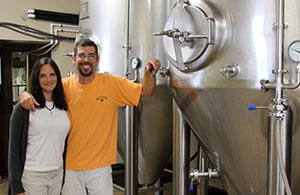
Since the mid-1970s, when the national Brewers Association started tracking craft breweries, through the end of 2011, 1,247 craft breweries have opened and 421 of them have closed, a 34 percent failure rate. For brewpubs over that same period, the failure rate has been 48 percent.
Craft beer is built on a grassroots movement, according to J.T. Smith, the executive director of the Brewer's Association of Maryland. "We're all small, independently owned businesses," he said. "We don't have a tremendous amount of money like some of the larger transnational brewing companies have."
The recession didn't help those small business breweries either, said Paul Gatza of the national Brewers Association. "Beer is not recession proof. And the recession did impact craft breweries, but not as much as the larger brewers," he said.
"After things calmed down, we really saw craft beer sales grow from low single digits up to double digits," Gatza said.
Eastern Shore
"I would say that I traded wearing a suit for wearing flip flops," Adrian Moritz said. "I also traded having Saturdays and Sundays off for working 120 days straight. It is a commitment that is rivaled only by parenting. It is all day, all night, every day."
He and wife Lori Moritz opened the doors to Eastern Shore Brewing in St. Michaels in August 2008, during the height of the financial crisis.
They had been living in upstate New York and homebrewing for several years while dreaming of starting a brewery "some day" but not wanting to leave the security of either of their jobs. Then they had a daughter, and Lori Moritz decided to take a buyout from her executive position at Xerox.
Six weeks later, Adrian Moritz was laid off. With no back-up plan, the couple started searching for an East Coast brewery location. They settled on St. Michaels on the Eastern Shore. Adrian Moritz's parents had retired there, and they thought the small town environment would be a good place to raise daughter Joycelyn.
"We sold every single thing that we owned to have collateral for a loan," Adrian Moritz said, including two homes they had renovated and sold.
The bank loan allowed them to rent and completely renovate part of a former mill on St. Michaels' main street. They've self-financed three brewery expansions since then by putting all brewery profits back into the business, living with Adrian Moritz's parents and having a steady paycheck from Lori Moritz's job as a contract administrator with Sotera Defense in Easton.
"It was a lot harder than we thought," Lori Moritz said. "Every time we turned around we were spending more money, spending more money."
The Moritz family said they could see the recession's effect on St. Michaels when less visitors came to town and local stores started to close. But they said the visitors that do come are buying more beer.
Keeping expenses down, using social media and a focus on customer service to market themselves and a successful tasting room have kept them in the black. They've also found a support network with other St. Michaels businesses.
Eastern Shore Brewing bottled its beer for three years before the Moritzes realized they were making more money from tastings and distributing draft beer. They now produce about 400 barrels a year with distribution up and down the Eastern Shore. They recently expanded to Delaware and hope to be in Anne Arundel County soon.
They'll keep the tasting room open late if there is even one customer in the store. The Moritzes, their brewmaster Randy Marquis, their bartender, and friends that know the beer do all the events and promotions themselves.
"In this economy, any opportunity to make a dime that you don't take on, somebody else will," Adrian Moritz said.
Another example of success? "We're married, we have a daughter, we live with our parents and own a business together and we haven't killed each other yet," he said.
Union
Jon Zerivitz and Kevin Blodger dove into uncertainty when they left their jobs as a freelance designer for T. Rowe Price and as head brewer at Gordon Biersch Rockville respectively to open Union Craft Brewing in the Hampden-Woodberry neighborhood of Baltimore in June.
"To up and leave for something with no clear future yet was definitely scary and still is scary," Blodger said. "But I think we're succeeding. I think we're doing a good job and we're trying to look forward to the future smartly."
"A little uncertainty in your life can be a good thing and motivate you to do bigger things," Zerivitz said.
Both Baltimoreans have young children, but had the support of their wives and a desire to get more into the creative side of brewing by branching out into their own business.
Like Eastern Shore, the Union brewery start-up cost a lot more than expected. Most of the funds they'd raised from investors were gone by the time they'd completely renovated a sign factory on Union Avenue.
But business has been good so far, with strong word of mouth promoting the brewery within Baltimore. They've got almost 2,000 followers on Facebook and great foot traffic.
"I think that people were just really excited there was a brewery [here]. And people love good beer," Blodger said.
A couple of awards in their first year can't hurt either. Union's Balt Altbier won a gold medal in German-style altbier at the American Beer Festival in Denver in October and they took home several awards at this year's Brewer's Association of Maryland Governor's Cup.
Union is brewing 100-150 barrels a month right now and wants to be up to their 12,000 barrel capacity in five to 10 years. Their ultimate goal is to be a strong Mid-Atlantic brewery that's part of the fabric of Baltimore.
As Zerivitz put it, "I'm building something for the city and for my future and for my own family's future."
Baying Hound
Like the Union guys, Paul Rinehart of Baying Hound Aleworks in Rockville had his wife's support in starting a nanobrewery.
"My wife also wanted her basement back and told me to go and get a warehouse," Rinehart joked. "So that's what I did."
Rinehart has beer in his blood. His maternal great-grandfather was on Carlsberg's board of directors, his paternal great-grandfather was a bootlegger in the 1920s and Rinehart himself started home brewing when he was 14.
He tried a career as a chef before swearing he'd never step in a kitchen again. In 2010, he used about $30,000 to start up Baying Hound. "I wanted to start small and scalable," he said.
Rinehart says that dealing with the paperwork and bureaucracy of having a brewery is challenging but he loves that he and his brewing partner are brewing beer "the way we want to do it."
He says Baying Hound is breaking even right now but doesn't make enough beer yet to turn a profit. Rinehart hopes to expand soon to a new location with a 15-barrel system and start distributing kegs. A good distributor also helped Baying Hound expand its draft and bottling reach from about eight to around 50 locations in Maryland, Washington and Virginia.
As for the recession, Rinehart doesn't think it affects beer, repeating a common adage in the craft brewery world: "When things are good, people drink beer. When things are bad, people drink even more beer."
Tuppers
Two people who have drunk a lot of beer in their day are Bob and Ellie Tupper, who together own Tuppers' Beers Co.
The pair started keeping tasting notes on their beer tasting trips in 1979 and have since recorded about 22,500 beer tastings. After thousands of tastings, they took a look at their tasting notes and saw some commonalities in what made a great beer.
"We sat down and realized nobody had put these together," said Bob Tupper, who has taught history at Holton Arms Academy in Bethesda for 43 years.
So they created Tuppers' Hop Pocket Ale in 1995, brewed by their friend Jerry Bailey, the then owner of Old Dominion Brewing Company. The beer amassed a cult following in the Washington area until Old Dominion was sold and the new ownership didn't have space to continue brewing Hop Pocket.
After a few years break in production, the Tuppers found a new brewer for Hop Pocket along with sister beer Tuppers' Keller Pils at St. George Brewing Company, a small brewery in Hampton, Va. Hop Pocket beer returned to stores in 2010. But now because of production costs, a four pack goes for $11. Despite that high price, the beer continues to have a low profit margin for the Tuppers.
"Never open a small business of any kind unless you are prepared to not make a dollar for the first year," Bob Tupper said. He also says a brewery needs to have enough money for a full year of operation before diving into the brew kettle.
Asked why they never set up their own brewery, Bob Tupper said that both he and Ellie Tupper, who is a senior production editor for the American Society for Microbiology, like their jobs and neither wanted to run a brewery full-time.
"It is a ton of work," he said. "I work hard as a school teacher but I don't work as hard as someone who works at a brewery."
Tuppers' Beers Co. may not be growing quickly, Bob Tupper said. "But we are really committed to making good beer."
TIMONIUM - Given Maryland's expanding craft beer market, it seems only logical that the state is also home to a number of festivals celebrating the art of beermaking.
Sponsored by the Brewers' Association of Maryland (BAM) each autumn, the Das Best Oktoberfest showcases a variety of local breweries at the Timonium Fairgrounds. In addition to beer, Das Best Oktoberfest offers other aspects of the German festival experience, including traditional German foods and music.
"It's a fun, accessible way to showcase Maryland beer in a family-friendly environment," said J.T. Smith, executive director of the Brewer's Association of Maryland (BAM). "The idea of having an Oktoberfest and celebrating our German heritage and having oompah bands is a fun, accessible way to celebrate."
Celebrating its fifth year in 2012, Das Best Oktoberfest has quickly become the largest and most popular of these festivals.
"We're very, very happy with the outcome this year," Smith said. "We're still summing up our financials from the event but it looks to be in line with the growth that we're wanting to experience on an annual level."
Das Best Oktoberfest's success should come as no surprise, given the state's rich German heritage. During the 1800s, a large number of German immigrants called Baltimore home. This tradition continues today, as German-Americans make up about 15.2 percent of Maryland's total population, according to U.S. Census Bureau's 2011 American Community Survey.
According to its website, BAM, which was founded in 1996, aims to "foster and promote Maryland craft beer and the community associated with it."
"As a non-profit trade association, we completely run our own funding mechanisms, so our larger events and festivals are a large portion of our annual budget. It's something we do, quite frankly, to raise funds but in a manner that celebrates Maryland beer in a family-friendly environment," Smith said.
In addition to Oktoberfest, BAM also puts on The Maryland Craft Beer Festival at the Great Frederick Fairgrounds every May. BBQ, shopping, live music and children's amusements accompanied the 15 local breweries that participated in this year's festival.
Maryland is also home to several other beer-centric festivals and the number is growing. This year marked the first annual Annapolis Craft Beer and Music Festival, while the Pratt Street Ale House in Baltimore produces the Chesapeake Spring Real Ale Festival, which celebrates cask beer.
Lasting ten days, Baltimore Beer Week is the longest beer-centric festival in the state. Occurring each October, Baltimore Beer Week features craft brewing companies from Maryland and the surrounding region at events hosted by bars throughout the city.
During Baltimore Beer Week 2012 alone, beer lovers could indulge at 417 events over ten days. Each year, the festivities are kicked off by the "Opening Tap Celebration," located at Power Plant Live in the city's Inner Harbor district.



ABV: Alcohol by Volume - The amount of alcohol in a beer, measured by percentage. The most common way to measure a beer's strength.
Barley: A cereal grain which is malted and turned into the mash of a beer.
Barrel: A unit of measurement used by brewers. The exact amount in a barrel varies from country to country; a U.S. barrel holds 31.5 gallons of beer, or approximately two full kegs.
Body: Used to describe the overall characteristic of a beer based on degree of thickness. A beer can be full-bodied, medium-bodied or light-bodied.
Bottling Rig: Mechanism used to dispense beer into bottles for packaging.
Brewpub: According to the Brewers Association, a brewpub is "a restaurant-brewery that sells 25% or more of its beer on site."
Brew Kettle: A large tank in which hops are boiled into the wort. Also known as a "copper"
Cask: A barrel-shaped container used for fermentation, carbonation and storing of beer. Though historically made from wood, most contemporary casks are made from metal.
Conditioning Tank: A tank in which beer is matured, clarified and naturally carbonated after primary fermentation.
Draft (Draught): Beer extracted directly from a cask, keg or other serving tank as opposed to bottles or cans.
Dry-Hopping: The process of adding hops in the final stages of brewing in order to increase a beer's hop aroma without considerably increasing its bitterness.
Fermentor: A large tank in which beer is stored during the primary fermentation process.
Gravity: A measure of the alcohol content of a beer. It is determined by comparing a beer's liquid weight to the liquid weight of an equal volume of water.
Beer traditionally falls into one of two categories: ale and lager. Within these two categories there are several styles differentiated by both variations to the brewing process and different types and amounts of key ingredients: hops, malt, and grain.
Ale: These sweet and full-bodied beers date back to ancient times and are worldwide favorites, especially in England where they're widely produced and consumed. Ales use "top-fermenting yeast," a yeast that rises to the beer's surface during the fermentation stage of brewing. Ales are typically served in a pint glass. Show Types
Amber: Amber ales are sweeter than pale ales due to the excess malt used in the brewing process. It also has a darker color, which explains its name: "amber" ale.
Gose: This crisp and refreshing German-style ale uses 50 to 60 percent wheat and is unfiltered. It's spicy and sharp from the use of coriander seeds and salt.
Pale Ale: An ale that is both malty and hoppy. English styles are typically spicy, while American styles tend to be more fruity.
Hefe: A style of wheat beer that is unfiltered and made with yeast still in suspension, which gives it a cloudy character.
IPA: India Pale Ale, simply known as IPA, is a bitter ale made with excessive amounts of hops. The style originated back in the 1800s when extra hops were added to preserve the ale during long voyages from England to India.
Stout: Distinguished by the use of unmalted, dark-roasted barley and minimal hops, this ale can be enjoyed in multiple styles: dry, cream and oatmeal. Sweet caramel or chocolate aromas are typically associated with stouts.
Porter: Malt and hop levels vary with porters, but this ale is always very dark and made from heavy-roasted malt.
Weisse/Weizenbier: A style of wheat beer with low bitterness and notable banana and clove aromas from the yeast used in the brewing process.
Lager: Known for their smooth, crisp taste, lagers are fermented and matured at low temperatures. The production of lagers relies heavily on "bottom-fermenting yeast," or yeast that tends to settle on the bottom during fermentation. This leads to a cleaner, more clear beer. Show Types
Bock: A German beer traditionally served in the spring, bock lagers are typically dark in color and sweet in taste.
Dunkel: The original German-style lager, dunkels are are dark amber in color and have a moderate alcoholic content. Dunkel flavors are often reminiscent of chocolate, licorice and coffee.
Marzen: Also known as Oktoberfest beer, Marzens are full-bodied and dark in color. Historically brewed solely in Munich for the Oktoberfest celebration.
Pilsner: First made in Czechoslovakia, a pilsner is a type of pale lager that is light in both color and taste. Pilsners are typically low in alcohol content, averaging about 4.5 percent abv.

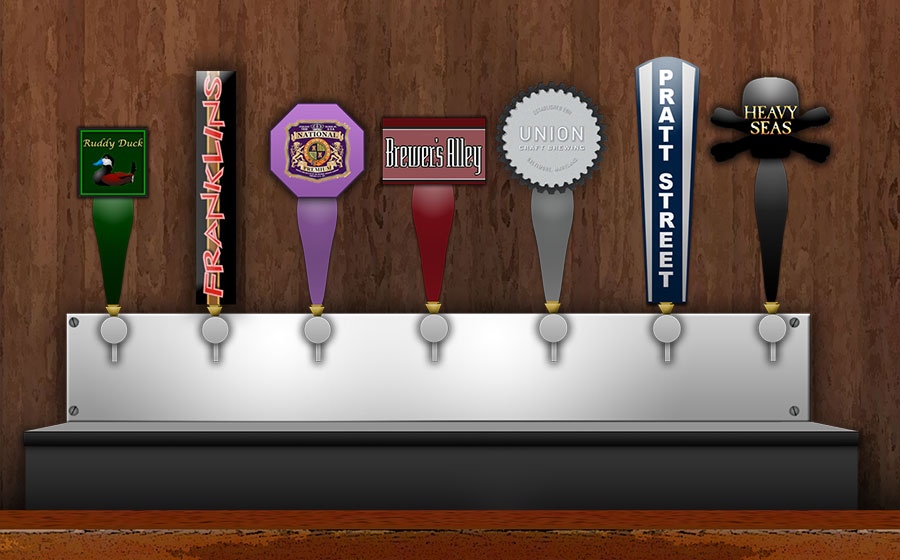


















SOLOMONS ISLAND - At the Ruddy Duck Brewery & Grill there are eight craft beers offered behind the bar, and a jovial duck mascot occasionally roams the dining room. This brewpub combines entertainment and affordable eats for kids with high-quality craft beer for moms and dads.
In the beginning, co-owner Carlos Yanez said he was nervous about combining a brewery and family-friendly restaurant. Families and their children are a significant part of the local community, and Yanez wanted the Duck to be a comfortable and accepting place for children and their parents.
"The idea of a brewery meant alcohol only and a bar, and that was not the point," Yanez said. "The point was to create a place where children can enjoy the ambiance and the food without being in an alcohol production facility. I love to have kids around. From the business point of view, kids draw business too."
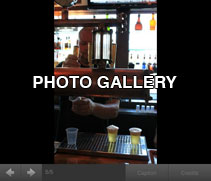
"We don't have a young clientele so being able to cater to families and beer enthusiasts is really easy," said Michael Kelley, co-owner and veteran restaurateur. "Both Carlos and I are fathers, I'm a grandfather, so we're both really in tune with families and we're catering to more of a baby boomer and 30-to-40-something crowd."
This out of the ordinary combination is evident from the entrance to the private dining room. On the walls of the Duck, there is a growing collection of artwork -- coloring pages of the Duck's mascot, Rudy, and several of his feathered friends smeared with bright Crayola hues. Next to the children's art, a window provides a bird's-eye view of the brewery where the Duck's award-winning craft beers are made.
That includes the Helles Lager that won "Best in Show" at the 2010 Brewer's Association of Maryland Governor's Cup.
"We manage to get everybody-- even different ages-- involved in this idea and they just love it," Yanez said. "Everybody's been taught here to make people feel comfortable no matter what age."
While Yanez cares for the families in his local community, he also cares about craft beer. Brewing is a passion and priority for Yanez and brewer Matt Glass. It's the marriage of good quality food and beer that bring the people in, Yanez said.
The Duck is involved in serious beer business. Brewery production is maxed out at 700 barrels produced per year, Glass said.
"If there's a tank made out of stainless steel it's filled or about to be filled. Nothing is empty," Glass said. "Tomorrow I'm going to transfer a couple of beers and then bam, bam, bam, brew right back-to-back and fill them up again."
The sky's the limit for Yanez and Glass when they face the challenge of creating a new craft beer. The duo work together to experiment with brewing. Every year Glass fills the restaurant with the signature fall scent of pumpkin pie as he brews a seasonal pumpkin beer. Recently, Glass created a gluten-free beer from sorghum, quinoa and honey that is, although not legally a true beer, surprisingly tasty.
"It's basically Matt's recipes and I let him free," Yanez said. "He came to me with the idea to make a gluten-free beer a few months ago and I was not really convinced but I said, 'Ok, go for it.' And it's been a hit, absolutely amazing."
"Carlos is really in tune with the little niche beers, the beer geeks we like to call them, who want something unique or extreme," Glass said. "I'm kind of in tune with the people who want consistent, year-round styles, the people who drink one beer."
Above all else, engaging with the local community is a top priority for the Duck. The business depends on connecting with customers when they stop in for a bite and a beer. Everyone caters to the local and vocal clientele.
"You're talking directly with these people and they'll tell you exactly what they think: if you're beer sucks or if they like it," Glass said.
The Duck frequently strives to mix and mingle craft beer with the local community. On Sept. 26, The Duck hosted its first one-hour class for local homebrewers, to educate them on the art of craft beer and the impact of flavors.
"It's about training your palette to identify off flavors and aromas: what caused it, what you can do to prevent it," said Glass, who led the class. He's hopeful these classes will convince homebrewers in the area -- and the members of a brand new local homebrewers club -- to increase their involvement in the Duck's annual homebrewing contest.
Every year the Duck initiates a challenge: craft a crave-worthy brew of a certain beer style. The contest is planned by Yanez and Glass, who select the specific beer style, to encourage homebrewers' brewing, and bring more business to the Duck. After professional judges select the winning beer, it is brewed in the Duck's brewery and then put on tap."
"You have to reach out to all in the community," Glass said. "Often people want to be a critique, so you have to educate them as well as listen to them."
HYATTSVILLE - With beers such as "Petite Fleur," a Belgian inspired ale made with a blend of flowers, on his resume, brewmaster Mike Roy has used his unique approach to brewing to breathe new life into Franklin's Restaurant, Brewery and General Store.
Since being hired in January 2010, Roy has experimented with beers such as "Pumpkin Pie Stout," "Ludicrous," an anaerobic sour ale and "Fin Del Mundo," a South American dark lager brewed with ingredients like maize, chocolate, spices and hot peppers, in honor of the Mayan Apocalypse.
"[My most creative beer is] the one that I have yet to brew," Roy said. "I think that's the important thing, to always be pushing yourself and never settle on that there is no way for something to be improved."

"I'm a student of brewing," Roy said. "I'm comfortable knowing that I will never know everything and saying I've perfected the craft would mean that I'm settling. I'm my own worst critic and I'm constantly trying to push myself to be better. Personal pride in my craft recognizes that good isn't good enough."
Roy said he sometimes engineers a beer based on a desired flavor outcome, while other times he simply brews a beer using ingredients he likes and hopes for the best. Roy's inspiration leads to truly unique beers.
"It comes from everywhere," Roy said. "It comes from trying other commercial beers, trying homebrewed beers, trying various food dishes. Raw materials. Sometimes I'll be turned on to a certain spice or ingredient and try to figure out how to incorporate that into a beer. Sometimes its just curiosity as what certain combinations of malts, hops or yeast will actually take effect."
Sometime, inspiration strikes Roy while listening to music or watching movies.
"I was inspired a couple weeks watching a documentary called 'Jiro Dreams of Sushi,' a film about an 85 year old Japanese sushi chef," Roy said. "What did it have to do with brewing? Nothing. What did it have to do with passion and pride in your craft? Everything. If at 85 year of age a sushi chef can still find passion in slicing and serving fish, how can I as a brewer ever lose my passion for making fermented grain beverages?"
Since he first broke into the business, Roy has always tried to be on the cutting edge of beer making.
"The things that I may have considered to have been unique five or ten years ago are kind of run of the mill now," Roy said. "In the early 2000s I started brewing some aggressively hopped IPAs. We didn't really have a name for them yet; it wasn't really a double or imperial IPA. They were just big IPAs. That within itself has become it's own category."
For Roy, blazing the IPA trail was a simply a matter of following his taste buds.
"My reason for brewing bigger IPAs at the time was no different than a spicy food lover adding more hot sauce to their chili," Roy said. "I loved hop bitterness, flavor and aroma, so I just started increasing the amounts we used. Once double IPA began to be recognized amongst the community, then there was almost a free license to start experimenting and the 'arms race' was on."
Roy's propensity for extreme and unique beers was honed over his decade-long career, which includes a stint at the esteemed Boston Beer Works, which produces Samuel Adams.
"I consider myself a 21st century American brewer. By saying that, I don't really consider myself to have any boundaries at all," Roy said. "What I try to do is operate to the best of my ability, trying to keep producing what I believe is quality beer, keeping the varieties evolving and changing. I think in this day and age American craft beer drinkers are really looking for what's new, what's next."
Aiding in his quest to push the limits of modern brewing, Franklin's owner Mike Franklin gives Roy as much creative freedom as possible by taking a hands-off approach to the brewery.
"The reason Mike [Roy] likes it here is that we have to have four or five basic beers on at all times," Franklin said. "After that he's free to knock himself out and do whatever creative seasonals he wants to do."
This freedom has proved beneficial not only to Roy, but to Franklins as a whole.
"One aspect is about kind of challenging myself to learn and be consistent and produce quality beer, but on the other side we're still a business and part of that is that we have to brew what will sell," Roy said. "The American palate has changed a lot in the last 15 or 20 years. Things have changed now and there are so many options out there that we need to diversify the lineup if we really want to compete."
Franklin's began brewing beer in 2002 and has since become a staple of the Hyattsville community and beyond. By the turn of the decade, however, it had become apparent that it was time for a change at the brewmaster position.
After placing an advertisement in the trade publication The New Brewer Magazine, Franklin received numerous responses from various locations across the country.
Out of the pool of applicants, Roy's experience caught Franklin's eye.
"I had checked out his reputation in New Hampshire and he had a good reputation as a brewer so when he came down to interview, we hit it off," Franklin said. "He thought this was a better opportunity than what he had up there."
Beginning his career on the other side of the industry, Roy worked as a bartender on Bourbon St. in New Orleans and for a marketing company doing liquor commercials in New Hampshire.
Roy did not start brewing until 2000 when he learned the craft at IncrediBREW, a Nashua, N.H., establishment where the public can make their own beer, wine and soda. Four years later, Roy had become the head brewer at Milly's Tavern in Manchester, N.H., before taking a position at Boston Beer Works in 2007.
"At Beer Works we had four brewpubs in the production facility and there was just a lot of corporate involvement and it just was not really my style," Roy said. "I wanted to get back to a single-entity place where I can have a lot more control over every aspect of the brewery."
When Franklin was planning on adding his restaurant to the already established general store, he knew he had to make his business unique to the area.
"When we were going to open in what was then considered a very, very unlikely spot to open a big restaurant, I wanted the additional draw that I knew having the brewery would be," Franklin said.
Since then, Franklin and his establishment have become the cornerstone of the Hyattsville community.
"We really more consider ourselves the local brewpub," Franklin said. "We support all of the local little charities, we're very family driven, we're very family friendly so it's kind of more like a traditional British pub from that point of view, where all ages show up."
Though he considers his market anybody living in a 15-minute radius, Franklin has been taking measures, such as attending the Brewer's Association of Maryland's Octoberfest and making Franklin's beer available at other bars, to increase awareness of his restaurant throughout the region.
"We are, actually, starting to sell our beer in D.C.," Franklin said. "We're probably going to have 10 or 12 bars in D.C. selling our beer, but that's really done more to market our place here, to bring them here, more than anything else."
Roy's passion is evident in the quality and variety of his beers, something that Franklin believes sets his establishment apart from other brewpubs in the region.
"Our product is our product and I think we do a really good job," Franklin said. "In terms of the beer itself, I think if you look at the variety, variety is the key. The span of stuff that we produce compared to most brewpubs, it's quite impressive."
DOVER, Del. - National Premium, an old Baltimore staple beer and competitor to National Bohemian returned to shelves earlier this year, thanks to an unlikely entrepreneur.
Tim Miller, a real estate agent from Easton purchased the National Premium trademark in an attempt to resurrect an old brand, despite having zero brewing experience.
"I've never brewed beer. The only time I've ever brewed beer was here watching these guys," Miller said, gesturing towards the brewers busy at work at the Fordham & Old Dominion Brewery in Dover, Del., where his National Premium beer is currently being brewed on contract.
Instead, with trademark in hand, Miller turned to an old friend, Jim Lutz, CEO of Fordham & Old Dominion Brewery, for help.

"He contacted me a couple of years ago and I told him he was nuts, that the craft beer business and the beer business in general was a tough competitive market and to stay in the real estate business," Lutz said. "He kept badgering me and, about a year and a half ago, I said 'all right, you obviously have the drive, let's make this thing happen.' So we started talking then and here we are now."
Despite his initial apprehension, Lutz not only agreed to contract brew National Premium at his Dover plant, but also provided Miller with some business advice.
"[Lutz] was like 'Well, I don't know why you would want to get into the beer business, but if you do it, just do one beer, do it well,'" Miller said. "His recommendation was to do it in cans and just jam it out there."
With the exception of choosing bottles instead of cans, Miller heeded Lutz' words of wisdom and the pair began brewing National Premium at the Fordham & Old Dominion plant late last year.
Currently, National Premium uses about five to seven percent of the Dover plant's capacity, according to Lutz. As the contract brewer, his company makes a few cents per case of National Premium sold.
"A lot of these contract brews come and go," Lutz said. "This one had some history, had some legs, it's going to work. People remember that brand from back in the 50s and 60s and we had extra capacity at the brewery."
Founded in 1872, National Premium reached the pinnacle of its success during the decades following World War II. During this time, the beer was marketed by the National Brewing Company as the upscale alternative to the company's flagship beer, National Bohemian.
"It was like the Maryland high-end beer before there was such as thing as craft beers and high-end beers," Miller said.
Following several changes of ownership over the previous few decades, National Premium had been absent from liquor store shelves across Baltimore since being discontinued in 1996.
Until recently, that is, when Miller obtained the National Premium trademark at an auction in New York City.
In November 2010, Miller stumbled across an advertisement in the Wall Street Journal for a trademark auction headlined by Meister Brau, a popular regional beer from Chicago dating back to the 1800s.
"I saw that, and I thought, 'OK, cool, that's it,' not knowing anything about the trademark business or what was for sale or how to do it," Miller said. "I took down the website, went to my desk and logged in and there were 150 different trademarks this guy was selling. I go under beverages, beer, there were three of them and I saw National Premium and I was like 'holy s**t, I can't believe this!'"
Miller immediately put down a deposit on the auction, booked a hotel room and bought a train ticket ticket to New York City.
"I told my wife what was going on and she thought I was crazy," Miller said. "It was the depths of the real estate recession and she was like, 'We have no money and you're doing what?'"
Miller went on to win the auction and obtained the rights to the National Premium name.
After he obtained the trademark, however, Miller was still faced with the issue of putting together a recipe. Almost immediately after he created his website, Miller received inspiration from a National Premium superfan.
"The very first day the site went live, I got a call from a guy," Miller said. "He was like 'I can't believe it, you're making my dreams come true! You're bringing back National Premium, it's my favorite beer of all time. I'm a collector of their stuff, it was the best beer!'"
According to Miller, this was just the first of a hundred of similar emails and phone calls that he received. Given the reaction, Miller knew he had to stay true to the original recipe.
He eventually got in touch with Ray Kilmovitz, a former brewmaster at the now closed Carling brewing plant in Baltimore, where the beer was once made. Kilmovitz provided him with the old recipe, re-written from memory.
With Miller's dream realized, National Premium returned to shelves statewide in June. Additionally, Miller hosted a launch party at the Owl Bar during Baltimore Beer Week in October.
While National Premium may have made it's triumphant return to the Maryland beer scene, its long-term success is not guaranteed. Was Miller, an inexperienced realtor, the correct person to bring back the classic beer? Lutz sure thinks so.
"He's born and raised in Maryland, he's a beer drinker, and I think he has the passion for what it takes to relaunch, if you will, a nostalgic brand," Lutz said.
The relaunch of this particular brand, according to Lutz, is important to the Maryland beer scene.
"I think it speaks to the brewing heritage of Maryland and the great brands that used to be in Baltimore or in the state of Maryland back in the day," Lutz said. "I think it shows that we've got some old nostalgia brands too. It's not just PBR, it's not just those old brands, but we've got some good brands in Baltimore and here's one of them so I think it's a good thing for the craft brew industry."
FREDERICK - When it came to picking a major in college, Tom Flores took a different approach to one many college advisers might suggest.
"I figured I'd pick a degree in what I struggled with the most in high school so that I could tackle it and not feel defeated by it," he said.
That meant biochemistry, which had challenged him in high school. The degree in turn led to Flores' decision to make his homebrewing hobby into a full-fledged career as a brewer. Today, Flores is the brewmaster at Brewer's Alley in Frederick and he still loves a challenge.
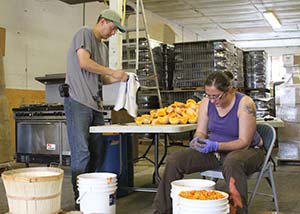
On an early fall afternoon in the brewery's new Monocacy Brewing Company facility, he and head brewer Maggie Lenz slowly but surely made their way through barrel after barrel of local squash as they prepped the ingredient for the brewery's seasonal Oh My Gourd! Pumpkin Ale.
As Lenz cleaned pulp and seeds out of halved pieces, Flores carefully watched squash roasting in an industrial-sized oven.
"What we're trying to be consistent at is delivering the fullest, most complex, most intriguing flavor that we can for any given beer," Flores said.
He has been at Brewer's Alley for 15 years, and his boss, Phil Bowers, said Flores has helped streamline the brewery and helped it grow through its recent expansion.
"He's very meticulous, very quality conscious," said Bowers, adding that Flores also loves to talk beer with anyone. "You can pretty much get cornered by him for hours at a time because he's very passionate about it."
Flores knew he was interested in beer long before he was legally allowed to drink it. His childhood friend Ashton Lewis' parents would bring back beer from trips to places like the Caribbean and Israel and let the two then high school-aged boys try them.
Together the high schoolers commandeered brewing equipment owned by another friend's dad and started experimenting. Lewis remembers the first beer they made from an Irish stout beer kit had way too much roasted barley in it and was "god awful."
But they eventually turned out some good batches. Flores pointed out that the beer he made as a high schooler was legally his parents. "I just happened to be the one making it," he chuckled.
While studying biochemistry at the University of Maryland, College Park, Flores interned one summer with Wild Goose Brewery in Cambridge. That internship firmed up his decision to be a brewer. In 1992, he went to UC Davis for a master's degree in food science and technology with an emphasis in brewing. It was the only accredited university brewing program at the time.
While he was at UC Davis, Flores met Hugh Sisson, a Baltimore restaurateur who was starting up Clipper City Brewing Company and had come out to California for a short brewing course. Flores introduced himself to Sisson, "letting him know he wasn't the only Marylander in L.A."
Sisson was impressed enough with Flores to offer him a job with Clipper City even though Flores was not yet done with his masters.
"He took a really big risk on me because at that point I only had about three months of practical brewing experience," Flores said.
Flores found himself finishing his master's thesis back in Baltimore while assisting with site scouting, digging trenches and designing Clipper City's brewing facilities. He helped launch the company, which now is better known for its Heavy Seas Beer brand.
"This was like jumping into the deep end," Sisson said. But Flores was a quick learner.
"Tom is a scientist," Sisson said. "He's going to approach things from a very analytical, very detail-oriented, very documents-focused approach."
That led to a high-quality product at Clipper City. But Sisson thinks production brewing, with its emphasis on getting beer out in large quantities on a certain time schedule, didn't exactly hit Flores' brewing sweet spot.
In 1997, the brewmaster opportunity at Brewer's Alley, which is a brew pub that also distributes beer, presented itself. Flores said he was looking for a new challenge, so he took it. He's created most of the seasonals and a few year round beers at the brewery while perfecting the quality of others.
Sisson regularly runs into Flores at brewery events and said that Brewer's Alley seems like a great fit for him.
"Doing the flat out production side like we do, that's not for everybody. But that's not a reflection of talent or ability," Sisson said. "I think he can be successful on my side of the business but I think he's happier on the side he's in."
Flores, who almost double-majored in history in college, is also on a historical brewing kick thanks to two outside commissions. St. Mary's City asked Brewer's Alley to brew a beer for its 375th anniversary. He used a recipe and ingredients that would have been used by colonists. Thus was born "1634 Ale," which is now on regular rotation at the brewery.
The brewery is currently in the midst of a two-year brewing project where it will make nine Civil War era beers for the National Museum of Civil War Medicine in commemoration of the war's 150th anniversary. Flores said the experience has been like "alternative history." He's tried to create a beer that would've been recognizable to someone alive during the Civil War or colonial America.
"It's a little bit of a stretch of fantasy to imagine this person tasting your beer who would have been alive back then," he said. "The neatest part of that is when you actually have someone who is alive today go and taste it and love it."
The historic recipes match with Flores' brewing philosophy -- melding time-tested recipes and techniques with new tools and technology.
Childhood friend Lewis said you might call Flores a beer geek. "Tom's very analytical. He really likes to dig into the details," Lewis said. "And that's the cool thing about beer, there's a lot of opportunity to dig into details."
Sisson also classified Flores as a beer geek. "But you have to understand that this industry was built on the backs of beer geeks," he said. "God bless the beer geeks. The industry wouldn't be the same without them."
Flores admits that he's a methodical and detail-oriented brewer. But he said that while beer is often described as "an art and a science," he sees it as an art first and foremost.
"[Science] really is subordinate to the most powerful tools of brewing which are the palate and the mind," he said.
Phil Bowers said that Flores does not do anything fast. "He takes the time to investigate what we need to do," he said. "He's very focused on putting out best product that we can."
But Flores says that just because he is deliberative in his brewing doesn't mean he avoids experimentation.
"Some of the greatest adventurers in the world spent years planning their adventure," he said. "The entire brewing experience is one great adventure."
BALTIMORE - Kevin Blodger has loved craft beer ever since he picked up a homebrew kit as a college student. He's been a professional brewer for over a decade and co-founded Union Craft Brewing in Baltimore with Jon Zerivitz in fall 2011.
Blodger is one of the few African American brewers in the U.S. And that's something he'd like to see changed.
"The craft beer community is not that diverse, no matter how much they say it is," Blodger said. "It's far and few between where you see blacks either in the business or as consumers."

There are prominent black brewers on the scene like Brooklyn Brewery brewmaster and author Garrett Oliver, whom Blodger credits as a big influence, and BJ's Michael Ferguson.
But as Blodger's business partner Zerivitz, who is white, said, "Craft beer tends to lean towards white males between the ages of 22 and 35."
The two hope that Union can attract a wider audience with its beer and appeal to Baltimoreans of all kinds.
"I want us to be a part of the people that make up the city," Blodger said. "I think if we reached out and showed them these great beers that are made locally by people in their neighborhoods, that we could triple or quadruple our market share."
Zerivitz agreed. "We both felt like we could look for ways to reach out to minority groups and women and try and just be as inclusive as possible."
Blodger said that he thinks blacks and Hispanics in particular aren't the target of craft beer marketing as much as whites because, "the majority of craft brewers are white so they're more comfortable marketing to their own demographic."
He also said that minorities are statistically less likely to have enough capital to start a brewery.
"I think each company consistently needs to look at what is right for their brands," said Paul Gatza of the national Brewers Association. "I think many already market to a wider range of beer drinkers than the typical white male in his 20s or 30s."
Gatza pointed out that there is a rising number of women craft brewers in particular.
The beer that Blodger and Zerivitz create at Union is pretty diverse in and of itself. They like experimenting with unusual one-time beers like a coriander and salt gose German-style beer, a hoppy red ale, and a lightly smoked saison (pale ale) flavored with malt that Baltimore food truck Blacksauce Kitchen smoked for them and Stillwater Artisanal Ales.
Union has two year-round beers: Duckpin Pale Ale for the hops lovers and a German-style Balt Altbier that won a Gold Medal at the 2012 Great American Beer Festival in Denver. There are plans to make their semi-regular marzen, Blackwing Lager, a year-round beer when they get more tank space. And Zerivitz said they'd love to do a beer inspired by the band Talking Heads.
Blodger didn't always want to be a brewer. The stout 36-year-old was born in Baltimore and raised in Herndon, Va. He went to the University of Maryland, College Park, to study journalism before switching to English.
Blodger got an initial taste for brewing while working at Maryland Farms Super Liquors in Beltsville. He saw some brew kits collecting dust on a shelf and asked his boss if he could have one. Blodger also took home a copy of "The New Complete Joy of Home Brewing."
The result was "Greenbelt Porter," which he brewed up at his house in Greenbelt. "It wasn't great, but it was good," he said. "It was drinkable. My friends liked it. I was hooked from like right then."
But after a post-college job as District ChopHouse's assistant brewer didn't pay the bills, Blodger switched to working as a special education school crisis specialist.
It was his girlfriend (and now wife) Monica who kept encouraging him to go back to brewing full-time. Eventually Blodger found a job at Frederick Brewing Company, followed by one as head brewer at Capitol City Brewing Company's Inner Harbor location. In 2007, he got a job as head brewer at Gordon Biersch in Chicago.
Volker Stewart from The Brewer's Art in Baltimore said he can see Gordon Biersch's influence on Blodger in the less common, German-style beers that Union produces. "I think they're wonderfully drinkable styles of beer," he said.
Blodger credits his time at Gordon Biersch for helping him focus on consistency in his brewing. "It was almost like working a production brewery because we were doing the same five beers year in and year out, week in and week out," he said. But it also left him wanting to have more creativity in the brew process.
After he and Monica had their son Benjamin, Blodger accepted a job swap to be head brewer at Gordon Biersch's Rockville location so they could be closer to family. It was around that time that a college friend introduced him to Baltimore County-native Zerivitz, who was looking to start his own brewery.
"I immediately recognized that he was a really creative as well as technically proficient brewer so I knew he would be perfect for my project here," Zerivitz said. "Everyone in the industry sort of knows him and speak incredibly highly of him."
Union came together over the last two years. Part of its name origin goes back to the co-owners feelings that beer brings people together.
"Beer unites," Blodger said. "When there's a problem, you go, you sit down, you discuss it over a beer."
He hopes that the uniting power will eventually expose more people to craft beer.
"I think everybody likes flavorful beer," Blodger said.
BALTIMORE - Oliver Breweries' Pratt Street Ale House brewer Steven Jones crafts his brews with a story in mind. Whether it's about a personal experience or based on a bit of popular culture, each brew has a tale to tell.
Jones welcomed his first son into the world with a craft beer, Little William's Winter Warmer, released for the first time in 2001. After a blunt declaration from William, now 11-years-old, that he "was not little" anymore at age 7, the beer's name became William's Winter Warmer. Jones changes the beer as his son ages.
The alcohol content of the beer rises by one percent each year, making this year's William's Winter Warmer stronger with 11 percent alcohol by volume.

"When I was gonna have my first child, what else does a brewer do? I wanted to celebrate the birth of my son with the one thing I can do pretty well, which is make beer," Jones said.
Jones' second son received the same first birthday present from his father: Jacob's Summer Celebration, released for the first time in 2010. The craft brew is a definite tribute to Jacob, now 2-years-old. The recipe is based on his birth weight of 8.8 pounds.
"It is an amber ale of 8.8 abv that uses 8.8 pounds of bittering hops and 8.8 pounds of finishing hops. Because I am English and his mother is American I divided the hops equally between English and American varieties," Jones said. "Ironically, Jacob was born on July 4 so I chose an American variety of hops called Liberty as the main finishing hop. The beer is released on Jacob's birthday every year."
His beers' unique stories help Pratt Street compete in the Baltimore craft beer industry.
"There's a lot of competition on tap, even in our own pub there's a lot of competition between our own beers," Jones said. "So every once in awhile with the seasonals we do a brew with character of its own. Not just from the actual quality of the beer, but also from the name and the myth that surrounds the making of it. You've got to do anything you can to stand out in the marketplace."
Oliver Breweries, which began brewing beer at the Pratt Street location in 1993, is Baltimore's oldest still-running brewpub. It sits within walking distance of Camden Yards and M&T Bank Stadium. It's also in a city that supports craft beer and boasts multiple local brewpubs.
"There's a decent amount of people that come to the city to do the brewpub tour," owner Justin Dvorkin said. "They come to an Orioles game and see us and have a few beers. They go to the Brewer's Art, they go down to Max's. They make their way through."
"We get a lot of transient business, as opposed to a regular crowd," Jones said.
But because of Jones' eccentric brewing style, with inspiration coming at any moment from anything, there is a constantly changing selection of craft beer to savor at Pratt Street. "People know that when they come here they're going to get something new and unique," Jones said.
Production increases year after year for Oliver Breweries, according to Dvorkin. Last year, production totaled approximately 2,000 barrels. And roughly 36 new beers made their debut in 2011 alone. Oliver Breweries distributes a selection of its beers to Maryland, Northern Virginia and Washington, D.C., with the last two markets being relatively new and successful, according to Dvorkin. Currently, there are about 18 beers on tap at Pratt Street's bar.
And those brews can entertain more than taste buds when people discover the stories behind them.
There's Winter's Wolves, a dark ale dedicated to Jones' favorite band: The Sword. "Creating the recipe was pretty straightforward, I simply interpreted what I see in their music into an ale...big, bold, complex and uncompromising," Jones wrote in a blog entry detailing the story behind the brew.
And there's Shot Down In Flames, a golden ale inspired by the album cover art of "Jesus Use Me" by the Faith Tones. "Performing the miraculous transformation of water into beer (admittedly with a little help from malt, hops and yeast), we became quietly obsessed with the cover art of a record titled "Jesus Use Me" by The Faith Tones (stumbled upon on an internet site posting of the 50 worst LP covers of all time!)," Jones wrote on the blog.
Then there are the brews with family ties. Several recurring seasonal brews are tributes to members of his family. These are the brews near and dear to Jones, the brews he truly enjoys discussing while sipping a pint.
Currently, the British brewer is crafting a beer dedicated to his German mother. The idea for the dark smoked ale brewed exclusively with German malts came after a conversation Jones had with his mother during a recent trip to his parents' home in Tamworth, England.
"My mom said to me, 'How come you haven't ever brewed a beer for me and your dad then?' So I was like, 'Ok, that's it then!'," Jones said. The brew is a way to "make fun of my mother, mostly, because she's German. I've blamed her for WWII since I was a teenager. It all comes down to that really."
Visit Pratt Street next year and there could be a brew in honor of the newest addition to Jones' growing family. He and his wife are expecting their third child in June 2013. It's a natural reaction for Jones, because brewing based on what happens in everyday life is his style.
"I think stylistically the way I brew has just evolved over time," Jones said. "Obviously any brewer, I think, would be lying if he or she says they are not influenced by whatever else is going on around them."
HALETHORPE - Looney's Pub located off Route 1 in College Park and a pub in the heart of Savannah, Ga. have something in common. Both offer their patrons Heavy Seas Beer to imbibe and enjoy.
Heavy Seas, a Maryland-based beer company founded by Hugh Sisson under the Clipper City Brewing Company name, did not stay within state limits for long after it began beer production in its Halethorpe brewery in 1995. Over the past 17 years, the company has expanded distribution to 16 states along the East Coast and into the Midwest because, quite simply, it had to.
"We could not have stayed afloat if we were only going to do business in the state of Maryland," Sisson said. "When we first started this company 17 years ago, the real focus was to try to stay relatively local and to get fairly deep in the market. And at that point in time Maryland wasn't really quite ready to embrace, at least in the beer business, its local guys."
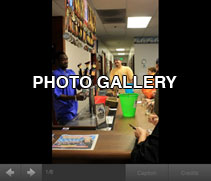
Fortunately, Maryland warmed up to craft beers and local brewers in the last decade. But the early expansion was the key to success for Sisson and Heavy Seas. "The cumulative effect of having 10 states buying your beer as opposed to being dependent on two or three made the economics begin to work for us," Sisson said. But as the expansion spurred growth, it also brought challenges.
"Sometimes the demand was greater than our ability to fulfill," Sisson said. "Once you get shelf space in a store or a draft line in an establishment, if you can't fulfill the orders and you lose them it's much more difficult to get them back."
With 40,000 barrels of beer produced this year and 55,000 barrels of beer expected next year, Heavy Seas keeps growing. It even outgrew its original 15,000-square-foot space and, over the past year, purchased adjacent space to bring the total square feet to 40,000, according to Heavy Seas marketing director Kelly Zimmerman. A two-year plan began July 1 to convert the new space into an area for packaging operations, freeing the old space for increased production with the addition of new equipment, such as a brand new bottling line.
"In about two to two and a half years we will be in a position where we have almost basically tripled the amount of product that we can produce within this local footprint," Sisson said.
More space and more beer does not add up to equal more distribution. According to Sisson, Heavy Seas does not intend to distribute to new markets in the near future.
"It's much more cost-effective to continue to sell, and hopefully sell more, products through an existing customer base than it is to get a new customer base," Sisson said. "I would rather be a big fish in a limited pond than a microscopic fish in a gimongous pond."
Expanding distribution is expensive. It takes time and money to find distributors in new markets. As the distance to the new markets increases, so do shipping costs. And the company must spend more time and money promoting itself.
"If the distances and the times involved in supporting the brand are more locally focused than you can spend more time doing what you're supposed to be doing with less time driving to get from point A to point B," Sisson said. "It's more efficient."
Heavy Seas learned the power of branding first hand. The distribution area is not the only aspect of Heavy Seas that evolved with time, so did the brand. The brewing company was not always known as Heavy Seas.
In the beginning, it was Clipper City Brewing Company. Heavy Seas was, at first, a brand of beer produced by Clipper City, along with the Oxford brand acquired by the company in 1997. After its 2003 debut, Heavy Seas quickly became very popular, according to Zimmerman.
In 2010, Heavy Seas became the dominant brand and all the existing beers were divided into three distinct product lines: the Pyrate Fleet of signature, robust brews like the company's flagship beer, Loose Cannon IPA; the Clipper Fleet of classic brews such as the Marzen; and the Mutiny Fleet of big and bold brews like the Siren Noire Imperial Chocolate Stout.
"The question before was, 'Are you Oxford, are you Clipper City, who are you?' And now we can answer that question with one answer, which is significantly more powerful than trying to answer that question with three answers," Sisson said.
The transition to Heavy Seas as the sole brand happened at the height of the recession in 2010. Despite the nation's rocky economics, the Heavy Seas team remained optimistic about profit growth, according to Sisson. In 2010 Heavy Seas' profits grew 35 percent, and in 2011 profits grew 55 percent, he said.
In 2005, Georgia-based Savannah Distributing Co. began distributing Heavy Seas in Savannah. Sales of the Maryland beer have grown by 25 to 30 percent each year, said John Schorn, Savannah Distributing's general sales manager.
Schorn attributes Heavy Seas success to its "great people, great beers."
Now, with an expansion underway, maintaining current distribution markets and decreasing the amount of beers produced from the current total of 18 are Heavy Seas plans for the future, according to Sisson. Heavy Seas is content with their Maryland roots and existing distribution. It's the right formula for growth.
"We've had pretty robust growth in the state of Maryland," said Sisson. "The local market is much more interested in supporting the local beers than they ever used to be. What was once frustrating is actually quite nice."



















